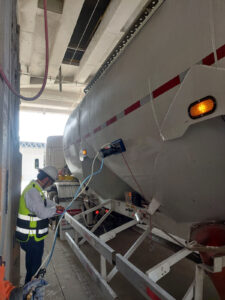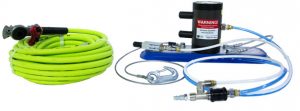 Cement manufacturers around the world must focus on keeping their costs down in this very competitive industry. With transportation of the product being a significant expense, it’s always a target for improvement.
Cement manufacturers around the world must focus on keeping their costs down in this very competitive industry. With transportation of the product being a significant expense, it’s always a target for improvement.
Recent advancements throughout the industry to significantly lower CO2 emissions caused by the cement production process have resulted in even finer and more aerated cement. An unintended consequence of the new product characteristics is that loading and unloading are even more difficult and time consuming, making the use of vibration even more critical to the solution.
Benefits of Using Vibration for Concrete Loading and Unloading
 Faster loading and unloading: Vibration fluidizes the cement product during both the loading and unloading processes which allows the product to flow quickly, without manual intervention or banging on the trailers.
Faster loading and unloading: Vibration fluidizes the cement product during both the loading and unloading processes which allows the product to flow quickly, without manual intervention or banging on the trailers.- Fully-loaded trailers: By removing air pockets and evenly compacting the cement, processing plants are able to get more than 5% additional product into each trailer when attaching a small vibrator to the side.
- Less product waste: Vibration during the emptying process also separates the residual material that would typically coat the sides and bottom of the trailer.
- Reduced fuel and transport expenses: Fuller trailers translate to less trailers being needed to complete the process, which leads to lower fuel consumption, less trailer wear and tear, and no trailer damage caused by banging.
- Reduced man-hours and better safety: Less people are needed to manage the loading and unloading processes when vibration is used, and not having to bang on the trailer eliminates the related potential employee risk.
- Reduced carbon emissions: The transport efficiencies contribute to the overall sustainability goals of the organization.

